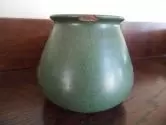Should You Buy A Chipped Piece of Art Pottery?

It was chipped.
The price was $90, a sizeable sum in 1985 to a struggling writer who had recently walked away from one career as a classroom teacher and a second as an antiques restorer. I loved the form, I loved the matte green glaze, I loved the Marblehead sailing ship impressed in the bottom, something you just didn’t come across in North Carolina.
But it was chipped.
Was I simply throwing away $90 on a piece of green clay, too squat to hold flowers, too small for anything other than loose change?
It rode back to North Carolina with me, wrapped up in a brown paper bag and stuck in the seat pocket of my Dodge Caravan. And for 28 years, for whatever reason, it has always been nearby, proudly displayed on one piece of Arts and Crafts furniture or another, right now a few feet away from me here in my office, always with the chip turned toward the wall.
There hasn’t been a day that I looked at it and didn’t appreciate the shape, the proportions and the glaze. And there hasn’t been a day that I haven’t forgotten the chip on the opposite side. Sure, I could have had it filled, but that wouldn’t have made it disappear from my mind. But if you want to do the math, my 28 years of enjoyment of that small, chipped Marblehead vase has cost me a whopping six cents a week, not quite a penny a day.
I asked a couple of antiques dealers who will be exhibiting at the Grove Park Inn Arts and Crafts Conference next month what they think about buying a piece of art pottery with a small chip or perhaps a hairline crack. Jean Oberkirsch noted, “If it is very hard to find or unique, or if you like it and are content to live with it the way it is, and the price is right, then go for it. For instance, the chance of owning an expensive mint Grueby vase may be slim, but you might be able to pick up a damaged piece at a reasonable price, and it would look great on your mission sideboard. But if you are buying strictly for investment, I would buy only mint and unique pieces.”
Fellow dealer and G.P.I. exhibitor Diane Cole concurred, “Yes, if a vase or tile is rare, unusual or seldom found, and the art work is great, I find that most collectors will purchase it.”
The funny thing is that last month I spent ten times what I paid for that small Marblehead vase on a piece of Arts and Crafts furniture, a piece that had been badly refinished, a piece that I knew I would have to re-refinish, yet I did not hesitate.
Which leads me to only one conclusion: collecting may be fun, but it isn’t always easy.
Next Week: Sizing Up Refinished Furniture

